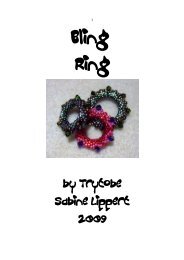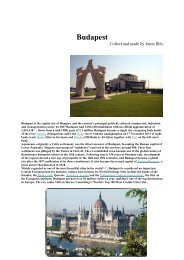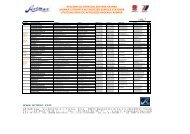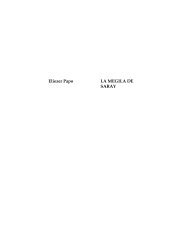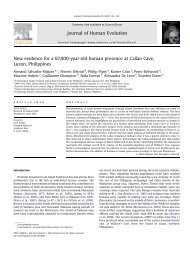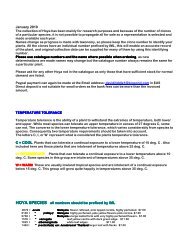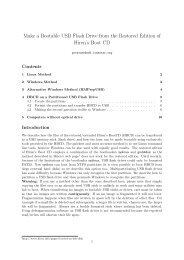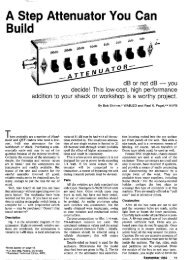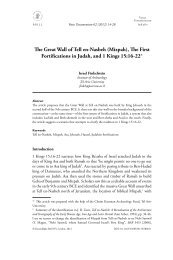ARTICLE IN PRESS Journal of Human Evolution
ARTICLE IN PRESS Journal of Human Evolution
ARTICLE IN PRESS Journal of Human Evolution
Create successful ePaper yourself
Turn your PDF publications into a flip-book with our unique Google optimized e-Paper software.
4<br />
Table 1<br />
Comparative species measured by sex.<br />
Family Genus Species \ _ U Total<br />
Colobinae Colobus Colobus guereza 2 2 1 5<br />
Colobus polykomos 1 0 6 7<br />
Colobus sp. 0 0 1 1<br />
Procolobus Procolobus badius 2 1 1 4<br />
Paracolobus Paracolobus chemeroni 0 0 1 1<br />
Cercopithecinae Cercopithecus ascanius 1 3 0 4<br />
Cercopithecus diana 0 1 2 3<br />
Cercopithecus erythrotis 0 0 1 1<br />
Cercopithecus hamlyni 0 1 1 2<br />
Cercopithecus mitis 3 7 1 11<br />
Cercopithecus mona 0 2 0 2<br />
Cercopithecus nictitans 0 0 1 1<br />
Macaca Macaca arctoides 1 0 0 1<br />
Macaca assamensis 0 2 1 3<br />
Macaca fascicularis 18 19 0 37<br />
Macaca fuscata 0 3 0 3<br />
Macaca maura 0 1 0 1<br />
Macaca mulatta 0 3 0 3<br />
Macaca nemestrina 7 6 0 13<br />
Macaca nigra 0 0 1 1<br />
Macaca ochreata 1 0 0 1<br />
Macaca sp. 0 1 0 1<br />
Macaca sylvanus 2 0 2 4<br />
Macaca thibetana 0 1 0 1<br />
Macaca tonkeana 1 5 0 6<br />
Mandrillus Mandrillus leucophaeus 0 1 0 1<br />
Mandrillus sphinx 4 5 0 9<br />
Papio Papio hamadryas a<br />
2 16 0 18<br />
Theropithecus Theropithecus gelada 1 2 0 3<br />
Theropithecus oswaldi 0 0 2 2<br />
with R 2 above 0.9 (Strasser, 1992). Estimated body mass <strong>of</strong> UB 330,<br />
based on calcaneus body mass regression equations developed by<br />
Strasser (1992), were compared to Plio-Pleistocene fossil primate<br />
body mass estimates, as retrieved from the literature (Delson et al.,<br />
2000).<br />
All analyses were performed using SPSS (version 16.0) statistical<br />
s<strong>of</strong>tware. The jackknife DFA procedure was calculated using R.<br />
Taxonomic comparisons and statistical results<br />
Description<br />
<strong>ARTICLE</strong> <strong>IN</strong> <strong>PRESS</strong><br />
Total 150<br />
a Papio hamadryas includes individuals assigned to five subspecies: P. h. ursinus, P. h. hamadryas, P. h. anubis, P. h. cynocephalus, and P. h. papio.<br />
A complete right calcaneus, catalogue number ‘Ubeidiya (UB)<br />
330, was found in stratum III 12 (Fig. 2). The calcaneal tuber, lateral<br />
process, and lateral edge are weathered. The calcaneal tuberosity is<br />
in advanced epiphyseal fusion corresponding to stage C in the<br />
development <strong>of</strong> appendicular bone in primates as defined by Galliari<br />
(1988), and the articular surfaces are well defined and angular.<br />
Age and bone fusion correlations for Old World monkeys (Papio and<br />
Macaca) suggest that fusion <strong>of</strong> the calcaneus begins between the<br />
ages <strong>of</strong> 3–4 years and is completed by the age <strong>of</strong> 7 (Bramblett, 1969;<br />
Kimura and Hamada,1990). This would suggest an ‘‘adolescent’’ age<br />
for UB 330 based on the age class <strong>of</strong> Kawai et al. (1983) and a nearly<br />
mature adult maximum length (Scheuer and Black, 2004).<br />
Within the Cercopithecidae, there are two subfamilial<br />
morphological patterns that typify adaptations for terrestrial and<br />
arboreal locomotion. The cercopithecine morphotype is adapted to<br />
increased stress during plantarflexion and inteversion as well as<br />
dorsiversion and eversion. In comparison, the colobine morphotype<br />
is adapted to an increased ability in grasping and the supination<br />
<strong>of</strong> the forefoot (Strasser, 1988). This results in a longer<br />
proximal calcaneal region in cercopithecines (a longer lever arm<br />
M. Belmaker / <strong>Journal</strong> <strong>of</strong> <strong>Human</strong> <strong>Evolution</strong> xxx (2009) 1–11<br />
and a better leverage for foot plantar flexion), a larger insertion for<br />
a bulkier m. triceps surae, and a wider and shorter posterior talar<br />
facet (reducing the sliding function, proximal inversion and eversion,<br />
and helicoid movement in the joint). In comparison, the<br />
morphology <strong>of</strong> Colobinae exhibits a shorter proximal calcaneal<br />
region, a longer and narrower m. triceps surae insertion, and<br />
narrow and long posterior talar facets, which serve to increase the<br />
precision and power in the mobility <strong>of</strong> the foot during movement<br />
across difficult terrain, such as branches, during arboreal walking<br />
and climbing (Langdon, 1986; Strasser, 1988, 1992).<br />
Figure 3. Linear measurements taken on UB 330 and modern comparative calcanei. A:<br />
Anterior view, B: Medial view, C: Superior view, D: Posterior view. These measurements<br />
correspond to the descriptions <strong>of</strong> Cal 1–14 in Table S1.<br />
Please cite this article in press as: Belmaker, M., The presence <strong>of</strong> a large cercopithecine (cf. Theropithecus sp.) in..., J Hum Evol (2009), doi:10.1016/<br />
j.jhevol.2009.08.004



